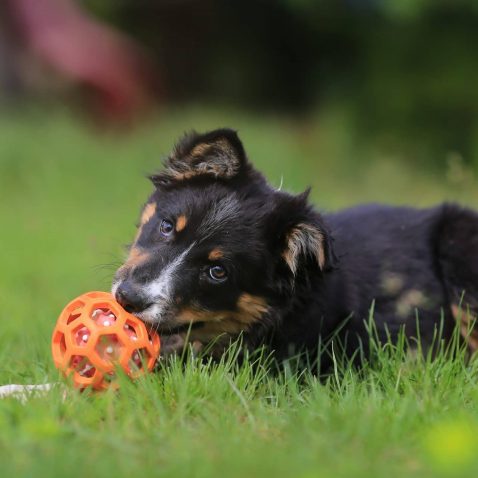
The Significance of Exercise

The Dangers of Lack of Exercise

Exercise Puppies & Adult Dogs - How Much Exercise Does My Dog Need?

Senior Dogs & Ones with Disabilities Benefit from Exercise Too

Types of Exercise That Provide Mental Stimulation for Dogs
Tips & Tricks for Even The Busiest of Schedules
The Significance of Exercise
Before we get into how much exercise your dog needs every day, it’s important to understand the significance of exercise for your pup.
Physical and mental activity is essential for a dogs well-being. It tones muscles and helps the body’s metabolic system, to function properly – not to mention it engages the mind.
It is especially important to make sure your dog receives adequate exercise if he is confined for periods of the day for example in a dog crate whilst guests are around or whilst being transported etc.
But it isn’t just dogs who are confined who need exercise, it is essential for all dogs and their well being.

Exercising is an excellent tool to keep your dog from becoming bored and destructive, as well as alleviate their anxiety and restlessness.
Playing a new game with your dog or introducing him/her to a new setting is also a fantastic way to improve their cognition. It will keep your dog alert and help them to process information.
When dogs get daily exercise, it has also been proven they’re more likely to have a longer, healthier life. It ensures that their joints stay lubricated while strengthening their muscles, as well as maintain a healthy weight.
Keeping your dog moving will help them look and feel good – both inside and out.
The Dangers of Lack of Exercise
If your dog doesn’t get enough physical exercise and mental stimulation, they may wind up with health issues. Which if left unchecked, can be detrimental – and even life-threatening.

If left unchecked, these could lead to:
- Destructiveness: Once your dog gets out for exercise daily, this behavior will typically decrease.
- Weight Gain: If you give your pup lots of dog treats, or feed them a high-calorie diet, they may become overweight. Especially if they don’t get enough exercise to burn off the calories they take in throughout the day. Being overweight can cause lots of issues for your dog such as joint and mobility problems or a sensitive stomach and diarrhea.
- Muscle Mass Loss (Muscle Atrophy): When this happens, it can be hard on your dog’s body.
When we lose muscle mass – we become weaker, and our bodies start to turn against us. This happens to our furry friends too.
Muscle atrophy (muscle mass loss) has some long term effects as well.
They may suffer from bone and joint pain from resulting arthritis. Or they may be affected by a reduction in growth hormones.
A reduction in growth hormones will cause your dog to inadequately process protein. Which is necessary to build and maintain muscle mass.
Some other symptoms that also occur from loss of muscle mass include:
- Rear limb weakness that progresses over time.
- Loss of full control of bodily movements. (Ataxia)
- Limbs that can’t support your dog’s weight
- Dragging of Paws
- When trying to stand or walk, crossing the legs.
- Muscles that are thinner and sunken.
Without physical activity, your dog will become bored, frustrated, and unhealthy. Which will have long-term, lasting effects that will only worsen over time if not corrected.
Exercise Puppies & Adult Dogs - How Much Exercise Does My Dog Need?
One determining factor on how much exercise your pup needs daily is their age.

How Much Exercise Does a Puppy Need Every Day?
As puppies have a lot more energy than adult dogs, it’s vitally important that they get enough exercise.
It’s important to note that younger dogs would benefit more from shorter periods of exercise, as too much can be hard on their developing bodies.
According to experts, “a good rule of thumb is a ratio of five minutes of exercise per month of age (up to twice a day) until the puppy is full-grown. Once they become adults, they can go out for much longer.”
Exercise is also a great way to socialize and train your new puppy. Leash training, for example, is essential to a well-behaved dog and also a great form of exercise!
How Much Exercise Does a Dog Need Every Day?
Even though adult dogs generally don’t require as much attention as puppies, most still require at least 30 minutes to 2 hours of exercise daily.
However, it is breed specific and that will be a critical factor in how much daily exercise your adult dog needs.
How Do the Different Breeds Play a Factor?
A high-energy breed, such as a Border Collie or Belgian Malinois, will require a lot more exercise in comparison to a low-energy breed like a Bulldog or Basset Hound.
You’ll want to research your dog’s breed(s) to really determine how much exercise your dog needs. Just like every person is different, every dog breed is unique and special in its own way.
Below is a general guideline on your dog’s potential energy levels – based on breed categories.
- Smaller Breeds: Smaller breeds, will generally tend to be less active.
- Giant Breeds: Despite their size and strength, giant dog breeds are generally known to be less energetic, as well.
- Flat-nosed Breeds: Flat-nosed or brachycephalic breeds suffer from breathing and respiratory issues, which causes them to slow down and live a more sedentary lifestyle.
- Active Breeds: These types of breeds thrive under plenty of exercise and action. Typically, they should be getting roughly 60-90 minutes of daily exercise to maintain their health.
Senior Dogs & Ones with Disabilities Benefit from Exercise Too
If your dog is older or has some form of a disability, you may feel it’s kinder to not exercise them. However, no matter how well-intentioned, it can be detrimental not to allow them some type of physical activity.
The fact of the matter is, dogs that are older and less active still need some activity to keep their bodies working as they should. Despite having physical conditions that can slow them down.

Senior Dogs
As we get older, we often aren’t able to uphold the vigor we took for granted in our younger years – in my case, especially. The same applies to our best friends as they age as well.
Your elderly dog may not be able to run as far, or long, as they used to. You may even be required to eventually restrict any running to a walk.
Proper exercise is just as important for a senior dog as it is for a puppy. Walks ought to still be an imperative role in a senior dog’s life.
However, they should be done at a slower tempo and be decreased in length.
Another great exercise alternative for your elderly dog is swimming.
Swimming will allow your senior dog to stay active without putting further stress on their joints. You can take your pooch for a swim in a pool or lake.
A good rule of thumb is to observe your dog’s behavior and talk to your vet. This way, you can determine the best way to go about making sure they still get the physical activity they require.
Dogs With Disabilities
For dogs with disabilities, it’s even more essential for them to get exercise.
For example, in regards to pups that have arthritis, physical activity helps keep their joints moving. A 30-minute walk should be of great assistance for them.
However, if you think your dog would experience too much pain to do so, talk to your veterinarian about pain medication and other pet health treatments.
For dogs that have specially equipped wheelchairs or carts – they may be able to continue to partake in water activities. Or if that is not an option for them, even enjoy a walk through the neighborhood.
Types of Exercise That Provide Mental Stimulation for Dogs
Whether they are a growing puppy, adult dog, senior dog, or have some type of disability that restricts them. There are many places and ways to incorporate exercise based off of your dog’s physical activity requirements.

All dogs can benefit from mental stimulation too. Even if they may not need as much physical exercise as before due to an injury or limited mobility – they still need a good brain workout!
Outdoor Exercise Options
- Hiking. When you go on your next adventure, bring your dog along to explore some new parks and trails in your area.
- Bicycle Walks. It may not be appropriate for all dogs, and cycling on the road is often dangerous. However, a lot of dogs go with their owners when they ride, and many towns have bike paths where they can safely accompany you.
- Skating. Your dog can join in on the fun whether you rollerblade or skateboard. Just be sure you both always wear the appropriate safety gear and start in an enclosed area while training your dog to this new activity.
- Swimming. It’s great for dogs with joint problems, as it provides low-impact exercise. Always be sure your pup is wearing a life-vest for their safety in the water when doing this activity.
- Fetch. This can be alternated with balls, frisbees, or other prized toys. Make your pooch run uphill to retrieve a ball, or by tossing a ball into the water.
- Draft Work. Larger breeds often enjoy draft work. Whether it involves a sled, a cart, or skijoring.
- Obedience. It might not seem like exercise at first glance. But practicing recall, retrieving, reinforcing basic commands, and learning fun new tricks offers mental stimulation – as well as exercise.
- Dog Sports. There are many to choose from, lure coursing, scent work, agility, obedience, flyball, dock diving, and Schutzhund (protection dog training) are just a few of the options. You and your dog can stick with your favorites or try a variety of activities.
Indoor Exercise Options
- Hide-and-Seek, a great game to get your dog moving and provide mental stimulation.
- Treadmill, this option builds endurance and does not rely on decent weather. It’s also a great dog exercise for high-energy breeds.
- Tug-o-war, this game will build muscle and your bond with your canine when done properly. Plus, there’s a wide variety of tug toys available!
- Agility, while typically associated with outdoor activities you can make your own agility course indoors with household supplies. Such as broom handles, boxes, Hula-Hoops, and ottomans.
Tips & Tricks for Even The Busiest of Schedules
When life gets busy, it can be difficult to squeeze in extra playtime for your pup. Fortunately, there are plenty of time-saving options available for busy pet parents. Making it easy to fit dog exercise into your jam-packed schedule.
- Investing in a Dog Walker, this is a great way to guarantee that your pooch gets the midday exercise he needs – 20 to 30 minutes should be more than enough.
- Dog Toys, excellent sources of fun for dogs who love loud noises, mysteries, and yummy surprises would be squeaky toys and food puzzle toys.
- Doggie Daycare, a great option for dogs who enjoy playtime and love to socialize outside of the house.
Summary
Exercise provides all dogs with mental stimulation and keeps them active. Which helps prolong their lives.
When combined with engaging mental and social stimulation, this is a great way to bond with your best friend. It will sufficiently tire them out, too – as the saying goes, “A tired dog is a good dog.”
However, in the end, as a dog owner, you know your pet best and will be the best judge of how much exercise they can comfortably handle.
We hope we have sufficiently answered “how much exercise does a dog need every day” for you.
We also hope you enjoyed this article, and if it was helpful to you in your dog exercise adventure! Let us know how these tips went for you – or if you have any questions.
We love to help, and we especially love to hear success stories!
Exercising your dog can also be a messy affair and our pups don’t always come home smelling fresh, so don’t forget to check out our product review for the best dog shampoo for odor.
Share the Love
If you found this post useful, please let others know about it by sharing it.
